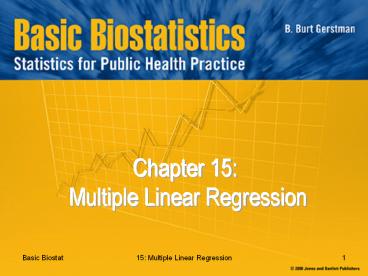15: Multiple Linear Regression PowerPoint PPT Presentation
Title: 15: Multiple Linear Regression
1
Chapter 15 Multiple Linear Regression
2
In Chapter 15
- 15.1 The General Idea
- 15.2 The Multiple Regression Model
- 15.3 Categorical Explanatory Variables
- 15.4 Regression Coefficients
- 15.5 ANOVA for Multiple Linear Regression
- 15.6 Examining Conditions
- Not covered in recorded presentation
3
15.1 The General Idea
- Simple regression considers the relation between
a single explanatory variable and response
variable
4
The General Idea
- Multiple regression simultaneously considers the
influence of multiple explanatory variables on a
response variable Y
The intent is to look at the independent effect
of each variable while adjusting out the
influence of potential confounders
5
Regression Modeling
- A simple regression model (one independent
variable) fits a regression line in 2-dimensional
space - A multiple regression model with two explanatory
variables fits a regression plane in
3-dimensional space
6
Simple Regression Model
- Regression coefficients are estimated by
minimizing ?residuals2 (i.e., sum of the squared
residuals) to derive this model
The standard error of the regression (sYx) is
based on the squared residuals
7
Multiple Regression Model
- Again, estimates for the multiple slope
coefficients are derived by minimizing
?residuals2 to derive this multiple regression
model
Again, the standard error of the regression is
based on the ?residuals2
8
Multiple Regression Model
- Intercept a predicts where the regression plane
crosses the Y axis - Slope for variable X1 (ß1) predicts the change in
Y per unit X1 holding X2 constant - The slope for variable X2 (ß2) predicts the
change in Y per unit X2 holding X1 constant
9
Multiple Regression Model
A multiple regression model with k independent
variables fits a regression surface in k 1
dimensional space (cannot be visualized)
10
15.3 Categorical Explanatory Variables in
Regression Models
- Categorical independent variables can be
incorporated into a regression model by
converting them into 0/1 (dummy) variables - For binary variables, code dummies 0 for no
and 1 for yes
11
Dummy Variables, More than two levels
- For categorical variables with k categories, use
k1 dummy variables - SMOKE2 has three levels, initially coded
- 0 non-smoker
- 1 former smoker
- 2 current smoker
- Use k 1 3 1 2 dummy variables to code
this information like this
12
Illustrative Example
- Childhood respiratory health survey.
- Binary explanatory variable (SMOKE) is coded 0
for non-smoker and 1 for smoker - Response variable Forced Expiratory Volume (FEV)
is measured in liters/second - The mean FEV in nonsmokers is 2.566
- The mean FEV in smokers is 3.277
13
Example, cont.
- Regress FEV on SMOKE least squares regression
liney 2.566 0.711X - Intercept (2.566) the mean FEV of group 0
- Slope the mean difference in FEV 3.277 -
2.566 0.711 - tstat 6.464 with 652 df, P 0.000 (same as
equal variance t test) - The 95 CI for slope ß is 0.495 to 0.927 (same as
the 95 CI for µ1 - µ0)
14
Dummy Variable SMOKE
b 3.277 2.566 0.711
Regression line passes through group means
15
Smoking increases FEV?
- Children who smoked had higher mean FEV
- How can this be true given what we know about the
deleterious respiratory effects of smoking? - ANS Smokers were older than the nonsmokers
- AGE confounded the relationship between SMOKE and
FEV - A multiple regression model can be used to adjust
for AGE in this situation
16
15.4 Multiple Regression Coefficients
- Rely on software to calculate multiple regression
statistics
17
Example
SPSS output for our example
The multiple regression model is FEV 0.367
-.209(SMOKE) .231(AGE)
18
Multiple Regression Coefficients, cont.
- The slope coefficient associated for SMOKE is
-.206, suggesting that smokers have .206 less FEV
on average compared to non-smokers (after
adjusting for age) - The slope coefficient for AGE is .231, suggesting
that each year of age in associated with an
increase of .231 FEV units on average (after
adjusting for SMOKE)
19
Inference About the Coefficients
- Inferential statistics are calculated for each
regression coefficient. For example, in testing - H0 ß1 0 (SMOKE coefficient controlling for
AGE) - tstat -2.588 and P 0.010
df n k 1 654 2 1 651
20
Inference About the Coefficients
- The 95 confidence interval for this slope of
SMOKE controlling for AGE is -0.368 to - 0.050.
21
15.5 ANOVA for Multiple Regression
- pp. 343 346(not covered in some courses)
22
15.6 Examining Regression Conditions
- Conditions for multiple regression mirror those
of simple regression - Linearity
- Independence
- Normality
- Equal variance
- These are evaluated by analyzing the pattern of
the residuals
23
Residual Plot
- Figure Standardized residuals plotted against
standardized predicted values for the
illustration (FEV regressed on AGE and SMOKE)
Same number of points above and below horizontal
of 0 ? no major departures from linearity
Higher variability at higher values of Y ?
unequal variance (biologically reasonable)
24
Examining Conditions
Normal Q-Q plot of standardized residuals
Fairly straight diagonal suggests no major
departures from Normality

